

Classic Buses Profiles
Eastbourne Corporation single deckers (by Dick Gilbert)
Last updated 24 January 2023

SOME LINKS WITHIN THIS WEBSITE: Home Email Links THE COMPLETE WEBSITE MENU Events Diary Halfcab list Small-Ads Classic Irish Buses Classic Manx Buses
Another look at some delightful vehicles from the past. This time they are from the famous holiday town on the south coast of England, Eastbourne, and it's the halfcab single deckers that are under the spotlight (which will come as no surprise to those who are familiar with these pages !).

No.12 at the Eastbourne Bus Rally, July 1993 (photo Dick Gilbert)
Eastbourne in Sussex holds a very special place in the history of bus transport, because its Corporation was the first municipality in the world to receive consent for a bus service. Their first vehicle, a 14-seat Milnes Daimler, commenced operations in April 1903, which was even before the days of registration number plates.
The town's bus service, later known as Eastbourne Buses, exceeded 100 years of continuous operation before its takeover by Stagecoach in 2009, and certainly operated a wide variety of interesting vehicles around the delightful and attractive resort, ranging from Clarkson steam buses and open-top De Dion Boutons to gearless Leyland Titans, but it is the single-deckers that are the subject of this page.
The selection here is completely subjective, as in the other Classic Buses Profiles pages, because the period being considered is only from 1930 to 1960. Purists will be aghast, but there it is. Accordingly, we are ignoring herein the very early Milnes Daimlers and Clarkson steam buses, and most certainly ignoring the Leyland Panthers and Leopards, and Daimler Roadliners that appeared from the late 1960s onwards (they do not count at all).
So the story really begins with a sizeable batch of Leylands supplied immediately after the first world war (because they were still around in 1930), and ends with the Corporation's one and only AEC Regal of 1950, which is happily still in service with them after a brief sojourn elsewhere. After the Regal, no other single deckers were acquired for fifteen years, which puts them beyond the period of this exercise.
I spent many holidays in Eastbourne during the 1950s, and moved there in 1959, so I remember the fleet very well during that period. However, the single decker was a bit of a rarity in the town at the time, and only the Regal No.11 and Leyland Lion No.12 were active, so they are the only two that I remember.
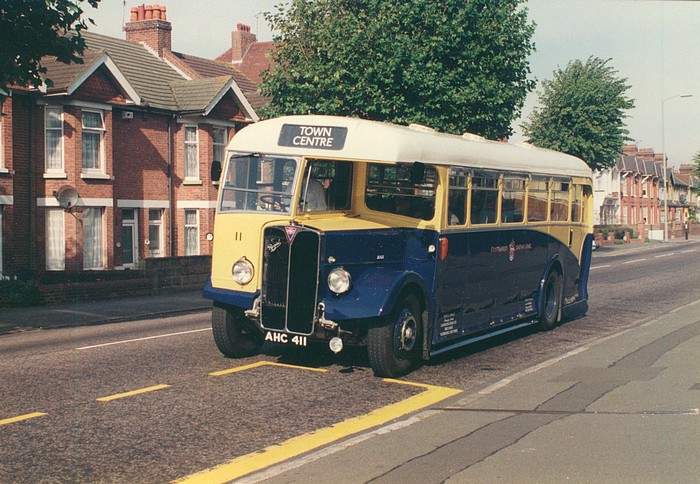
No. 11 in Eastbourne on 9 October 1994. Photo by Richard Martin.
I thought the pair were totally wonderful vehicles in my youth, the Lion because of its age and imposing demeanour, and the Regal due to its bodywork - possibly the most elegant and stylish bit of East Lancs craftsmanship ever, so I was astounded in 1993 to discover that BOTH had been preserved. They still live locally and can be seen occasionally at rallies in the area. The delightful Regal can even be seen in service sometimes! However, just because I never saw the earlier buses doesn't mean I wouldn't LIKE to have done, so this is a combination of memories and dreams.
A brief explanation of the Eastbourne Corporation numbering system would not go amiss. Basically, they simply numbered vehicles from 1 upwards, but no numbers over 100 were permitted. Therefore, when the sequence looked like approaching 100, they started again. The series therefore went round five times, eventually continuing beyond 100.
This means that a list in numerical order would be confusing, so it is instead arranged in date order. Some numbers were changed occasionally to allow new batches to fit into the system, and very old vehicles that were still in service when the sequence was going round again sometimes resulted in gaps or changes, but this will be explained as we go along. HC and JK are the two vehicle registration identities for the town.
The Southdown enthusiasts club has kindly given me permission to use some information from their publication Eastbourne Borough motor buses - the first 80 years published in 1983. My thanks to them for this, which has been of great assistance in preparing this page, and I recommend that you visit the Southdown enthusiasts club page. I must also acknowledge the invaluable help provided by various PSV Circle publications.
As with my other lists, the odd mistake is bound to creep in, and some relevant information may be missing so, in order to make it as accurate a reference as possible, I would of course welcome any additions or corrections.
FLEET LIST
LEYLAND S3 - 33-35 (total 3)
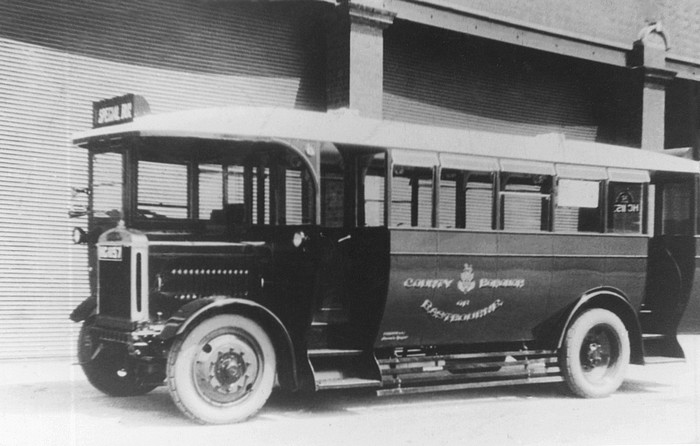
No.35, probably when newly rebodied as a single-decker around 1927, outside the Churchdale Road depot. (Photo: unknown)
Chassis built 1916 - see notes below
Chassis: Leyland War Subsidy S3 built in 1916. Rebuilt by the Corporation to forward-control in 1927.
Body: Originally given O20/18RO double-deck bodies from Leyland Bs No.33-35 (HC 589, 591 and 593) of 1914. Rebuilt with Eastbourne Corporation single-deck bus bodies in 1927-28, two with rear entrance and one (35) with a dual entrance configuration. In fact no. 35 may have been the only one of the three converted to forward control at that time.
Notes: These numbers were used twice in the first series (1903-1919). The original Leyland B chassis 33-35 of 1914 (HC 589/91/93) were requisitioned by the War Department later in the same year, but the bodies appear to have been retained. These bodies were then fitted to three new chassis acquired in 1916, and the three new vehicles were given the same numbers. Thus the numbers were re-allocated to the same bodies but on different chassis.
In 1927 the three vehicles were re-bodied again, this time with Corporation-built single deck bus bodies, and at least one (no. 35) was rebuilt to forward-control at the same time. As such they lasted until the mid-1930s.
LEYLAND - 1-6 (total 6)
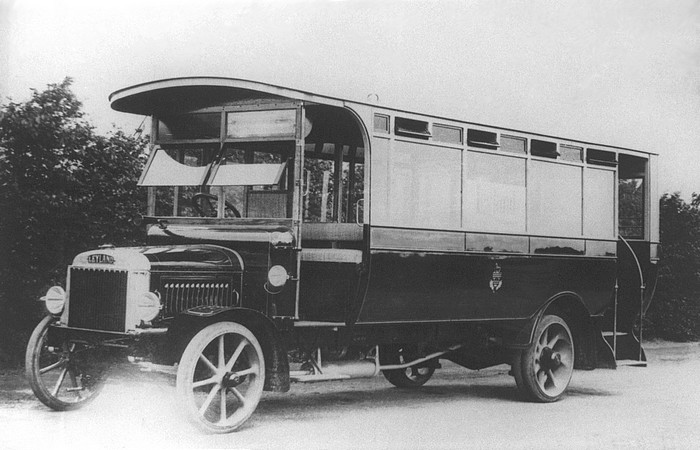
No. 1 in its original form with solid tyres. Photo: Roy Marshall Collection, via East Pennine transport group, Huddersfield.
Delivered in 1919
Chassis: Leyland normal control.
Body: Leyland/Vickers B32R bus bodies.
Notes: These vehicles were the first allocations to the second cycle of numbering (1919-1937). As delivered, they had solid tyres and extensive glazing in the passenger compartment, but pneumatic tyres were fitted in the 1920s. Like the previous batch, the registrations were all odd numbers only. The colour scheme was all-over blue.
LEYLAND PLSC1 LION - 40-49 (total 10)
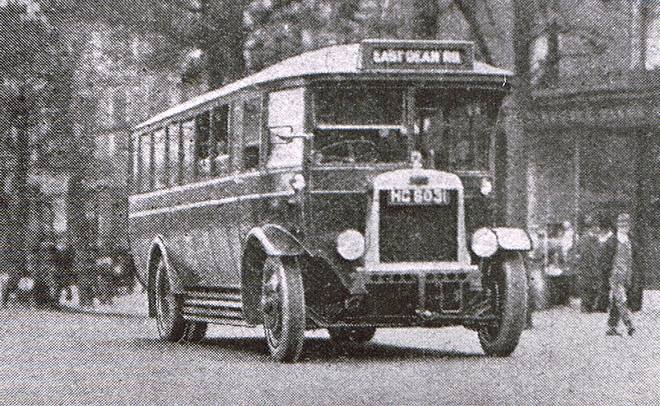
No.41 leaving the railway station for East Dean Road. Photo: Roy Marshall Collection, via East Pennine transport group, Huddersfield.
Delivered April-June 1926
Chassis: Leyland Lion PLSC1 (Eastbourne's first buses with pneumatic tyres).
Body: Leyland B32R bus bodies.
Notes: Once again, the registrations were odd numbers only, and the fleet numbers were from the second cycle (the first having finished at number 48). An all-blue paint scheme was applied.
LEYLAND PLSC3 LION - 50-59 (total 10)
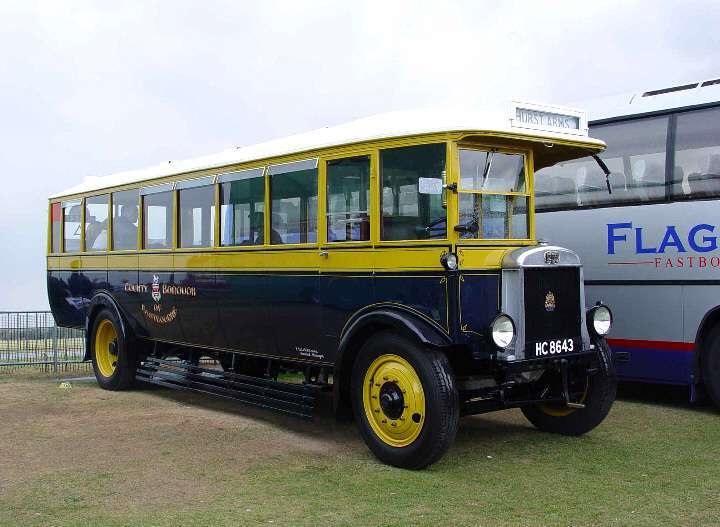
No.58 (HC 8643) as newly restored in 2003 and shown at the Eastbourne Buses Centenary Rally. Photo: Dick Gilbert.
Mark Winfield emailed me in May 2016 with some background to this vehicle. He said "just to let you know that HC 8643 used to be in my dad's granny's back garden in Ducklington Lane, Witney, Oxfordshire. As a child I used to play in it and my great granny used it as a potting shed and reading house in the summer. I remember a tree had grown though the back of its body before it was removed from the garden. The people who came for it found the starting handle, put it in reverse and wound it out of the garden via the next-door garden. 26 years had passed when the restoration was completed in 2003, but what a job has been done on that bus I played in a child."
Delivered in 1928
Chassis: Leyland Lion PLSC3 (longer than PLSC1)
Body: Leyland B35R halfcab bus bodies.
Notes: These continued the habit of using odd-numbered registrations only, and were from the second cycle of fleet numbering. These were again painted blue, but with white roofs and yellow window-surrounds.
DENNIS G (30 cwt) - 7-9 (total 3)
.jpg)
This photo (taken from a glass plate) was very kindly sent by Jim Type, and shows one of the Eastbourne Dennis G buses, probably when new at the Hall Lewis/Park Royal works at Abbey Road in North London. Jim was given the photo by the wife of a photographer who undertook commissions at the plant.
Delivered in August 1929
Chassis: Dennis G (30 cwt) normal control
Body: Hall Lewis B14F
Notes: These three vehicles were acquired in 1929 for winter seafront services. The choice of fleet numbers is curious, as the second cycle had already allotted 7/8/9, and the third series was also to use them on other vehicles. Therefore when, in 1937, they were all renumbered to nos. 97/98/99 it straightened things out somewhat and they definitely became part (the very end) of the second numerical cycle.
LEYLAND LT8 LION - 11-15 (total 5)
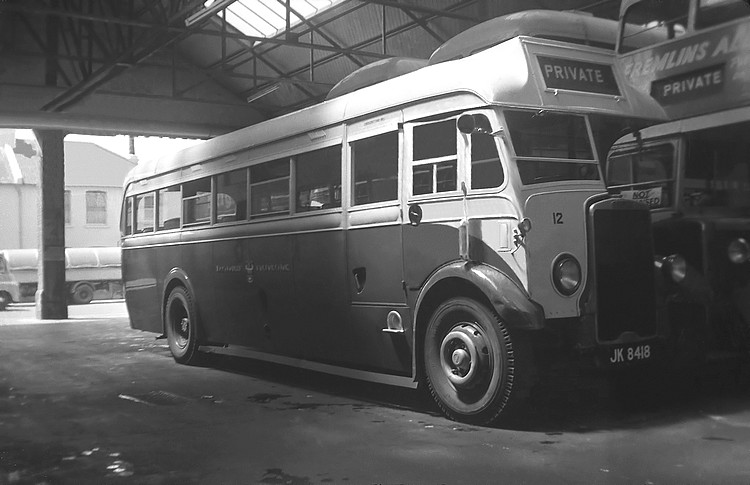
Lion No.12 at Churchdale Road garage in 1961. Photo: Dick Gilbert.
Delivered in August 1939
Chassis: Leyland Lion LT8 (there has been some suggestion that they may be LT9, but No.15 reportedly has a chassis plate identifying it as an LT8).
Body: Leyland B39F bus bodies with seats on four levels (highest at the back). By November 1939 two of them (probably nos. 12 and 13) had been modified to a conventional B32F. The other three went for military service unconverted.
Notes: These were in third cycle of fleet-numbering, the previous series having finished at no.96. These were the last petrol-engined vehicles acquired by Eastbourne. Although most of the batch had been requisitioned for military service within two years, no.12 remained, later becoming the last Leyland Lion in municipal service.
In order to convert it to diesel in 1954, no. 12 received an oil engine from an even older machine, an ex-Southdown Leyland TS7 Tiger of 1935.
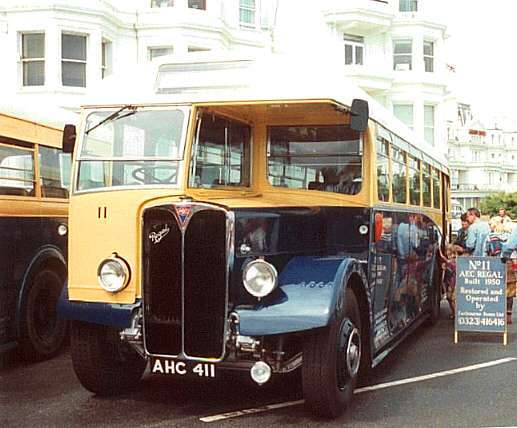
No.11 at Eastbourne Bus Rally, July 1993. (photo Dick Gilbert)
Delivered in July 1950
Chassis: AEC Regal III 6821A (Chassis number 6821A532), 7.7 litre engine and crash gearbox.
Body: East Lancs. Dual Purpose 30 seat, rear entrance (No. 4605). Intended for private hire, but often used for bus relief duties.
Notes: Another out-of-sequence number allocation, this time from the third cycle of fleet-numbering. The original no. 11 (third series) had been one of the Leyland Lions listed above, but this had been disposed of some nine years previously. In fact, in order to make way for a batch of Leyland Panthers in 1970 (how could they!) the Regal, still active, was renumbered to no. 93 in April. It was then sold in 1978 and went to a private owner in Little Staughton but, no doubt plagued by guilt and sleepless nights, Eastbourne Buses re-purchased the vehicle in September 1992 to restore it to full psv status. It is now maintained in beautiful condition and can often be seen around Eastbourne on special trips, rallies, or even in full passenger service when the modern fleet is under pressure.
Originally painted blue and primrose, it was later repainted cream with a blue stripe (in the late 1960's ?), but is now restored to its original colours.
TOTAL 38 (with 4 Survivors, 58, 12, 15 and 11)
For more Eastbourne buses see the double deckers, seafront buses, and Eastbourne buses photo album
For many other buses, have a look at all the other profiles on the Classic Buses menu page.
SOME LINKS WITHIN THIS WEBSITE: Home Email Links THE COMPLETE WEBSITE MENU Events Diary Halfcab list Small-Ads Classic Irish Buses Classic Manx Buses